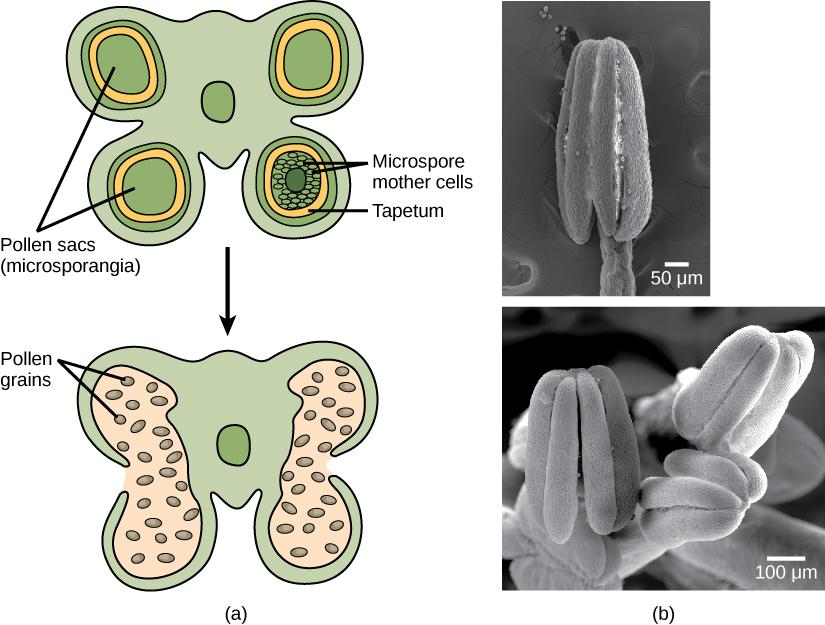Answer
390.9k+ views
Hint: It is the structure that houses the pollen grains in a flower. The microspores develop inside the microsporangium.
Complete answer:
- All flowering plants show sexual reproduction. A flower is the reproductive structure of a plant that contains the male and female gametophytes. The male reproductive structure is the androecium, represented by a whorl of stamens and the female reproductive structure is the gynoecium.
- Stamens are structures that contain pollen in terminal sac-like structures called microsporangia or anthers, also known as microsporophylls. Typically, an angiosperm anther is bilobed meaning each lobe is made up of two theca. Each anther is made up of four structures containing four microsporangia, two in each lobe, situated at the corners. The microsporangium appears nearly spherical in outline.
- It typically consists of four wall layers, namely, the epidermis, endothecium, middle layers and the tapetum. The three outer wall layers play protective roles and help release the pollen in anther dehiscence. The tapetum is the innermost wall layer and provides nourishment to the developing pollen grains. The tapetum cells generally consist of more than a single nucleus with a dense cytoplasm.

Fig: Microsporangia
- Microsporangia develop further into pollen sacs. They extend throughout the anther's length and are filled with pollen grains. A young anther has a cluster of compactly organised homogeneous cells known as sporogenous tissue in the middle of each microsporangium. The microspores separate and grow into pollen grains as the anthers mature and dehydrate.
Note: Microsporogenesis is the process of the production of microspores through a pollen mother cell by the process of meiosis. The microspores are found arranged in a four-cell cluster called the microspore tetrad.
Complete answer:
- All flowering plants show sexual reproduction. A flower is the reproductive structure of a plant that contains the male and female gametophytes. The male reproductive structure is the androecium, represented by a whorl of stamens and the female reproductive structure is the gynoecium.
- Stamens are structures that contain pollen in terminal sac-like structures called microsporangia or anthers, also known as microsporophylls. Typically, an angiosperm anther is bilobed meaning each lobe is made up of two theca. Each anther is made up of four structures containing four microsporangia, two in each lobe, situated at the corners. The microsporangium appears nearly spherical in outline.
- It typically consists of four wall layers, namely, the epidermis, endothecium, middle layers and the tapetum. The three outer wall layers play protective roles and help release the pollen in anther dehiscence. The tapetum is the innermost wall layer and provides nourishment to the developing pollen grains. The tapetum cells generally consist of more than a single nucleus with a dense cytoplasm.

Fig: Microsporangia
- Microsporangia develop further into pollen sacs. They extend throughout the anther's length and are filled with pollen grains. A young anther has a cluster of compactly organised homogeneous cells known as sporogenous tissue in the middle of each microsporangium. The microspores separate and grow into pollen grains as the anthers mature and dehydrate.
Note: Microsporogenesis is the process of the production of microspores through a pollen mother cell by the process of meiosis. The microspores are found arranged in a four-cell cluster called the microspore tetrad.
Recently Updated Pages
Basicity of sulphurous acid and sulphuric acid are

What is the stopping potential when the metal with class 12 physics JEE_Main

The momentum of a photon is 2 times 10 16gm cmsec Its class 12 physics JEE_Main

Using the following information to help you answer class 12 chemistry CBSE

Which of the following would not be a valid reason class 11 biology CBSE

Why should electric field lines never cross each other class 12 physics CBSE

Trending doubts
Difference Between Plant Cell and Animal Cell

Difference between Prokaryotic cell and Eukaryotic class 11 biology CBSE

Fill the blanks with the suitable prepositions 1 The class 9 english CBSE

Change the following sentences into negative and interrogative class 10 english CBSE

How many millions make a billion class 6 maths CBSE

Fill the blanks with proper collective nouns 1 A of class 10 english CBSE

Give 10 examples for herbs , shrubs , climbers , creepers

What organs are located on the left side of your body class 11 biology CBSE

What is BLO What is the full form of BLO class 8 social science CBSE



